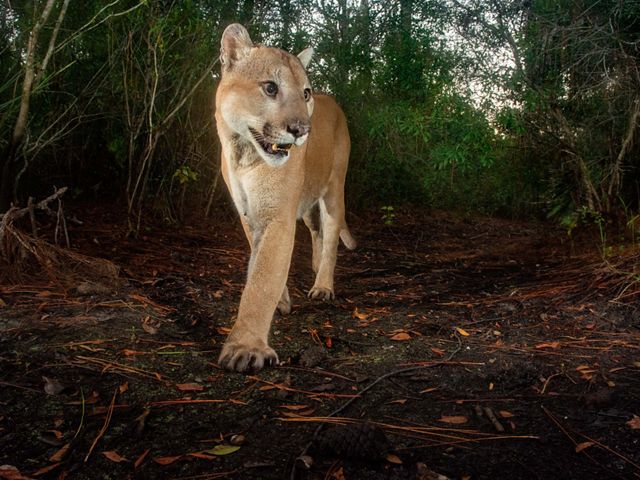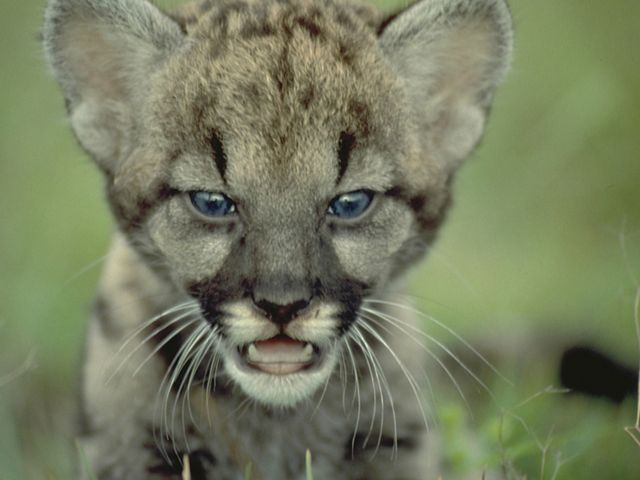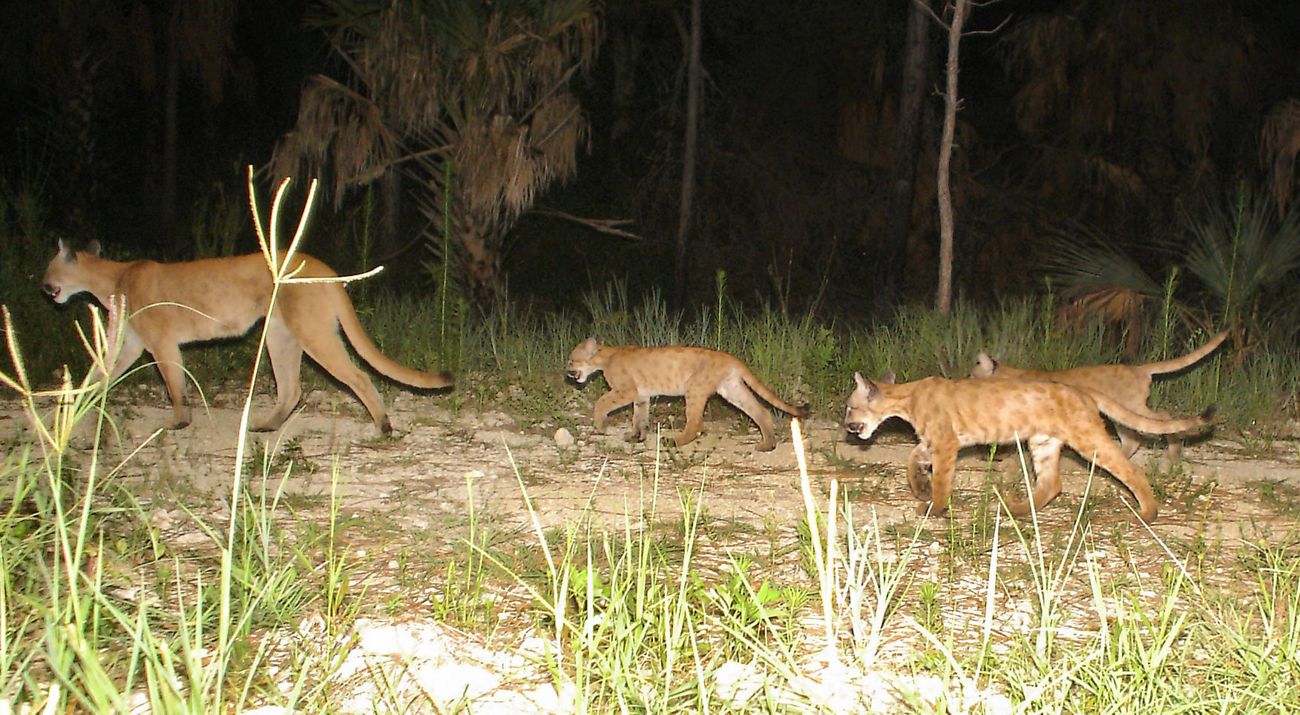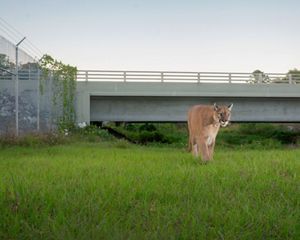Florida Panthers: Crossing the Caloosahatchee
Florida panther kittens have been seen north of the Caloosahatchee River for the first time in more than 40 years.
The story has all the elements of a Hollywood blockbuster.
It has cats (everyone loves cats).
It has celebrities: Florida panthers (our majestic state animal).
It has tragedy: Not long ago, only a few Florida panthers were left in the wild, under serious threat in a limited habitat, their extinction all but inevitable.
It has suspense: How can we help save an animal that can’t roam to new territory north of the Caloosahatchee River?
(Spoiler alert) It has a happy ending—panther kittens!

Threats to Florida Panthers
Every great epic has a backstory. Florida panthers—large, tawny-colored cats up to 160 pounds and more than 7 feet long from nose to tail—once flourished at the top of the food chain, ruling over the entire Southeastern United States from Carolina mountains to Louisiana marshes to the flowing wetlands of the Everglades. As humans began to encroach on their habitat, however, these majestic cats shared the fate of all our large predators. Their numbers steadily decreased, impacted by development and decimated by hunters, disease and, more recently, cars.

In the late ’60s, fewer than 30 panthers were left, concentrated mostly around Okaloacoochee Slough in Southwest Florida, cut off from their more expansive territory to the north. The small population was stressed by genetic mutations such as kinked tails, heart-related disorders and fertility problems. The human population, meanwhile, continued to press in around them. Subdivisions were eating up buffer zones and further eroding the panthers’ habitat. Vehicular strikes were taking a toll. Things didn’t look good.
But then, in the nick of time, a remarkable rescue effort kicked into gear (cue the arriving-cavalry-coming-over-the-hill music). Ranchers, government agencies and conservation groups put aside their often-conflicting agendas and united behind two goals: increase the panther population and expand their territory. By 1996, TNC and its partners had protected the 29,495-acre slough. Other critical panther habitat—including the Big Cypress National Preserve, Everglades National Park and the Florida Panther National Wildlife Refuge near Naples—were secured. Eight cougars (another subspecies of the Puma family) were brought in from Texas as a last-ditch effort to deepen the gene pool. A monitoring program (capturing, collaring, releasing and tracking panthers) produced dependable data. And, yes, panther numbers started edging up, the all-but-inevitable ending turning into cautious optimism.
Panthers Need Room to Roam
Today there are 160–200 Florida panthers surviving in the wild. But healthy numbers are only half the problem. More cats require more room.
“A male panther requires a territory of about 200 square miles,” said Greg Knecht, Executive Director for The Nature Conservancy in Florida. “The panthers are reaching their maximum density in southwest Florida, and the population just can’t grow much more unless they can expand into new territory.”
As early as 1994, TNC began laying the foundation for protecting a wildlife corridor made up of linked conservation areas that would allow panthers to escape populated areas in the southwest, cross the Caloosahatchee River (which runs from Lake Okeechobee to Fort Myers) and establish home ranges in the wide open areas of Central and North Florida.

The corridor started taking shape. Big Cypress National Park was connected through Hendry up to Glades County (Fisheating Creek). Between 1995 and 1997, TNC worked to protect land that is now Kissimmee Prairie Preserve State Park, followed by thousands of acres of working ranchland protected through conservation easements. In 2000, TNC helped protect the Spirit of the Wild Wildlife Management Area and, a year later, partnered with several private landowners and state agencies to protect 20,895 acres of panther habitat now known as the Dinner Island Wildlife Management Area.
Crossing the Caloosahatchee
Recognizing that reaching and crossing the Caloosahatchee River is critical to the panthers’ survival, TNC worked to protect two key properties that connect to the south side of the river. In 2012, TNC, in coordination with state and federal agencies, protected the 1,257-acre American Prime property through a series of conservation easements just prior to a foreclosure sale of the property. In 2015, TNC acquired a conservation easement to protect more than 1,527 acres at Black Boar Ranch, with the assistance of the U.S. Department of Agriculture.
“Getting this far is a monumental achievement,” Knecht said, “one that would not have been possible without the collaboration of everyone involved, starting with the ranchers. They gave us this opportunity.”
The Florida Department of Transportation installed fencing along the busiest roads, such as Alligator Alley and State Road 80, and built wildlife underpasses to ensure safe passage for panthers beneath these highways. Floridians have supported the cause, in part by buying 1.4 million panther license plates since 1993 (90% of the extra $25 collected from the sale of Florida panther specialty license plates goes to panther research).
Panther Kittens!
TNC is now focused on expanding the corridor north of the Caloosahatchee. Panther tracks and trail-camera images show males making their way across the river in greater numbers. For the first time since 1973, a female was photographed in Babcock Ranch Preserve Wildlife Management Area in Charlotte County. And even better news from recent months: A camera recorded two kittens trotting after their mother, the first such sighting in more than 40 years.

If Hollywood controlled the script, this is where the movie would end (zoom in for a kitten close-up, cue the music, fade to black). The real story, of course, isn’t over yet.
“The presence of a nursing female is a really positive sign,” Knecht said, “the first major step toward the establishment of a subpopulation. But 200 cats in the wild falls far short of a thriving species and we still have a great deal to do before the Florida panther is safely off the Endangered Species List. The corridor must be completed in the next 5 to 10 years or it will be too late.”
Florida Panther Facts
- Seminole legend says that the panther was the first creature to walk the Earth.
- Panther kittens stay with their mother for two years.
- Male panthers defend territories of 200 square miles.
- Panther litters vary from 1 to 4 kittens, although many do not survive.
What You Can Do
Donate
Support TNC’s Florida panther program or text the word PANTHER to 97779 to make a quick and easy PayPal or credit card donation.
Learn and share
Talk to others about saving the Florida panther. Good places to learn more: FWC Panther site, Florida Panther National Wildlife Refuge and Big Cat Rescue.
Drive slower
Many panthers are killed by vehicle strikes in Florida each year. Be especially cautious on roadways in panther country.



